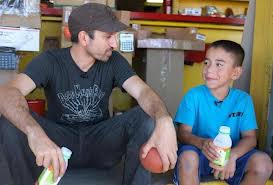
Kathy sat down with Laurie Kretchmar recently to discuss “Caine’s Arcade,” a viral sensation, and why everyone needs a “Nirvan.” Laurie is a communications pro and social media evangelist for great causes and companies. A former journalist for Fortune and Working Woman magazines, Laurie served as Editor in Chief and VP at Women.com Networks, the first major website for women. A graduate of Dartmouth, Laurie lives in the Bay Area. Laurie wrote about Caine’s Arcade on her blog as well.
Kathy Klotz-Guest (KKG): Can you summarize the story for our readers?
Laurie Kretchmar (LK): Caine is a real and imaginative boy in Los Angeles who created an arcade of games made of cardboard at his dad’s auto parts store. There was very little foot traffic until a customer and filmmaker named Nirvan Mullick happened upon it , surprised Caine by bringing hundreds of people to visit and made a short documentary about it. The video “Caine’s Arcade” took the Internet by storm. I was touched by Caine’s story and also Nirvan’s. Nirvan has since gone on to start a foundation to foster creativity in kids around the world. (Keeping it Human Note: The foundation is called the Imagination Foundation).
I also was interested in how a story like this struck a chord. I think people are hungry for good news, but not saccharine news. Nirvan has great anecdotes about people who’ve been touched by “Caine’s Arcade” including a burly Secret Service agent who said he cried when he saw the movie.
KKG: It’s a great human interest story. What part of it interested you most?
LK: As a former journalist, I always love to hear the story behind the story. In my blog I write about social media and marketing and topics that grab my interest. I recently heard of an altruistic kid who made a splash and I suspected his parents were heavily involved in the marketing of his idea, which they were. When I began to think about what we all need, I thought, aha – we need a Nirvan.
And here’s a secret – I knew that Nirvan was and is accessible via social media and would almost certainly retweet my blog post on Twitter. I was right, and he did. We tweeted “Who is your Nirvan?” He replied, “I’m my own.”
Nirvan and Building an Imagination Foundation
KKG: That’s very cool. Nirvan is a great champion who turned his experience into a Foundation to encourage creativity in kids. What lessons in advocacy can readers take away from this story? I can think of a few.
LK:
1) Be open to serendipity and possibilities. You could literally be replacing a door handle when you stumble upon a meaningful idea that transforms your life and those around you.
2) Look for allies! Who is most interested in what you’re promoting? As Ted Hope, an independent movie producer said at South by Southwest, “You have to find a way to conspire with people you have yet to meet.”
Storytelling for a Cause
KKG: This story is a such a great way to think about promoting a cause. However, I would say that many of us need ‘Nirvans!’ Why is having a Nirvan so important today?
LK:There is so much noise that it can seem hard to get attention for your great idea.
KKG: Amen! Preaching to the choir.
LK: Some of us feel shy tooting our own horn – so find someone else who will do it for you or help you become a thought leader. As I told one non-profit leader who had his first book coming out yet was reluctant to tweet, “It’s not about you! It’s about your cause. It’s letting people know about your work so they can learn more.”
To find your tribe, ask yourself, who shares my passions and interests? Search for them via social media. I’ve found some authors, editors and readers on Twitter who share my interest in certain children’s books. For instance I’ve celebrated the life of a great children’s book illustrator – Trina Schart Hyman whom I interviewed many years ago. I also recently mourned the passing of an author who was very influential to me and others – E.L. Konigsburg. She wrote “The Mixed Up Files of Mrs. Basel E. Frankweiler” about a young girl who hides out with her brother in the Metropolitan Museum of Art . Reading that novel as a young girl in California was the first time I envisioned New York City and I knew I would live there someday, which I did.
KKG: How can we increase our chances of running into and empowering others to be Nirvans for us?
LK: Look for us. We’re all around.
KKG: How can we be better Nirvans for others? It’s about really being present and recognizing the need and opportunity.
LK: True! Keep an eye out for natural allies. Introduce people with similar interests. It could be as simple as reaching out via a tweet. I just introduced two Illinois women via Twitter; one is a young activist promoting women in politics; the other an advocate for survivors.
Thanks, Laurie!






